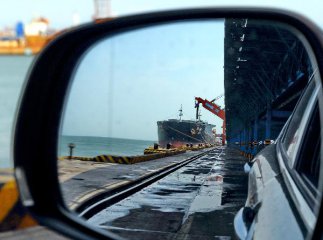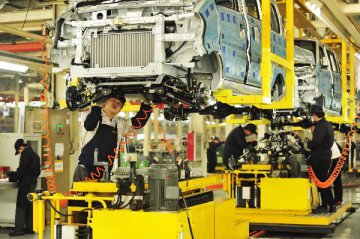 The purchasing managers' index (PMI) came in at 49.9 in July in China’s manufacturing sector, slightly lower than June's 50, according to data announced by the National Bureau of Statistics (NBS) on Aug.1. It is also the second consecutive drop recorded by the manufacturing PMI. Experts pointed out that data in recent months show that though the manufacturing economy is faced with downside pressure, its performance is stable on the whole. In the meantime, non-manufacturing economy remains active, and the transformation and upgrading of economic structure produce desired results. Chinese economy will still struggle to stabilize in the second half.
The purchasing managers' index (PMI) came in at 49.9 in July in China’s manufacturing sector, slightly lower than June's 50, according to data announced by the National Bureau of Statistics (NBS) on Aug.1. It is also the second consecutive drop recorded by the manufacturing PMI. Experts pointed out that data in recent months show that though the manufacturing economy is faced with downside pressure, its performance is stable on the whole. In the meantime, non-manufacturing economy remains active, and the transformation and upgrading of economic structure produce desired results. Chinese economy will still struggle to stabilize in the second half.Short-term factors drag PMI
As to the manufacturing PMI, a reading above 50 indicates expansion, while a reading below 50 reflects contraction.
After recording a reading above 50 for four consecutive months earlier, the manufacturing PMI in July dropped slightly to 49.9 percent. Zong Liang, chief researcher at the Bank of China, pointed out during the interview with SSN that though the PMI has dipped for two consecutive months, it shows stable performance in recent months with slight fluctuation around 50. On the one hand, it shows the downside pressure still faced by the manufacturing economy; on the other hand, it signals that the manufacturing industry tends to stabilize.
As to the reasons behind, short-term factors like heavy rainfall contribute a lot. Chen Zhongtao, deputy chief economist with the China Logistics Information Center, indicated that the PMI data usually drops in the same period of previous years with the advent of slack season. What’s more, high-temperature and rainy days as well as the floods in southern provinces also drag the data.
Data announced by the NBS shows that the sub-index measuring production stood at 52.1, 0.4 percentage points lower than a month ago. Provinces heavily attacked by floods like Jiangsu, Anhui, Hubei and Hebei see larger drop of the sub-index.
According to NBS statistician Zhao Qinghe, other factors dragging the PMI in July include that the growth of market demand slows down and expansion power remains weak; some traditional industries further address capacity and squeeze production. In terms of enterprises with different sizes, the PMI of middle and small-size enterprises has dropped for two consecutive months, the main force dragging the PMI in July.
Non-manufacturing PMI records new high
In contrast with the slight drop of the manufacturing PMI, non-manufacturing PMI shows outstanding performance and its growth further speeds up. China’s non-manufacturing business activities index in July stood at 53.9, 0.2 percentage points higher than that of previous month and a surge for the second consecutive month. The figure is also the highest this year.
“Non-manufacturing economy continues its characteristics and advantages. It has become a highlight of China’s economy. The constant sound performance recorded by non-manufacturing economy highlights the results produced by China’s improvement of economic structure, being of great significance in advancing China’s economic transformation and upgrading. So to speak, the rapid and stable development of non-manufacturing economy is what we have expected and fits into the demand of China’s economic development”, as indicated by Zong.
The service industry keeps developing. Zhao pointed out that driven by the finance industry and tourism consumption, the index for business activities of the service industry climbed 0.4 percentage points last month to 52.6, the highest record since the second quarter. It shows that the total scale of the service industry grows faster and the industry plays an increasing role in boosting economic growth.
Zhang Liqun, research fellow of the Department of Macroeconomic Research of the State Council's Development Research Center, remarked that the sound development of non-manufacturing industry means that China’s stable economic growth is underpinned by multiple structural changes. It will help us to judge future economic trend in a more comprehensive way.
Pace needs to be kept stable in H2
The PMI data in July, as a start for China’s macro-economy in the second half, let us know the pressure under economic downturn and shows accumulatively positive factors. Zong pointed out that facing this situation, China’s economy should hold the pace in the second half and advance economic transformation and upgrade based on stable economic operation. If this aspect is done well, the economy will maintain stable in the second half and manufacturing industry might achieve surprising performance at year end.
The Political Bureau of the Central Committee of the CPC stressed at a meeting recently that it should stick to moderately expand the total demand and continue to carry out proactive fiscal policy and prudent monetary policy. In the opinion of Li Huiyong, chief analyst on macro-economy from Shenwan Hongyuan, the highlight of proactive fiscal policy is to ensure expenditure and to reduce tax and expenses, and monetary policy will be maintained moderate and easing.
The transformation and upgrade of economic structure will be the key development field of China’s economy in the second half. The PMI data in July shows that besides outstanding performance of non-manufacturing industry, manufacturing field also highlights transformation and upgrade. Zhao expressed that PMI for high-tech manufacturing industry registered 53.2 percent in July, up by 1.9 percentage points from June and hitting a new high since the beginning of this year.
“The effect in transformation and upgrade of economic structure has been increasingly obvious since this year and it is closely related with the continuous promotion of supply-side structural reform. We still need to steadily propel supply-side reform and push forward five major tasks with de-capacity, destock, deleverage, reducing cost and shoring up weak spots.” said Zong. Promoting the transformation and upgrade of economic structure cannot be limited to the improvement in domestic supply and release of demand, but should also improve the opening-up level and drive the economic transformation and upgrade through the “Belt and Road Initiative” and internationalization of RMB, so that the transformation and upgrade will bolster the stable and sound development of China’s economy.
Translated by Jennifer and Vanessa






















Latest comments